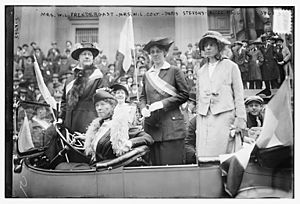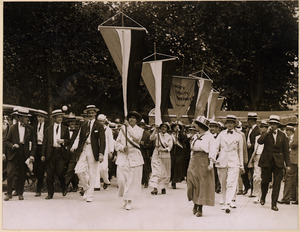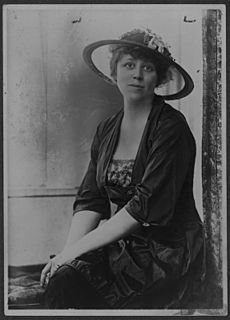Doris Stevens facts for kids
Quick facts for kids
Doris Stevens
|
|
|---|---|
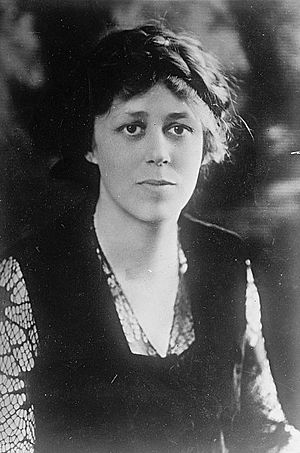 |
|
| Born |
Dora Caroline Stevens
October 26, 1888 |
| Died | March 22, 1963 (aged 74) |
| Education | Omaha High School |
| Alma mater | Oberlin College |
| Occupation | Suffragist, activist, author |
| Years active | 1913–1963 |
| Known for | Suffragist, women's rights advocate |
| Spouse(s) | |
Doris Stevens (born Dora Caroline Stevens, October 26, 1888 – March 22, 1963) was an American suffragist, a person who fought for women's right to vote. She was also a strong supporter of women's legal rights and an author. She made history as the first woman to join the American Institute of International Law. She was also the first leader of the Inter-American Commission of Women.
Born in 1888 in Omaha, Nebraska, Doris Stevens became involved in the fight for women's voting rights while studying at Oberlin College. After finishing college in 1911, she worked as a teacher for a short time. Then, she became an organizer for the National American Woman Suffrage Association's Congressional Union for Woman Suffrage (CUWS).
When the CUWS separated from the main organization in 1914, Stevens became a national leader. She helped plan a big women's meeting at the Panama–Pacific International Exposition in 1915. When the CUWS became the National Woman's Party (NWP) in 1916, Stevens organized women across the country. Her goal was to get a national law passed that would allow women to vote. She also worked to defeat politicians who were against women's rights.
Between 1917 and 1919, Stevens was a key participant in the Silent Sentinels protests. These protests took place outside Woodrow Wilson's White House. The women wanted a constitutional amendment for women's voting rights. Stevens was arrested several times during these protests. After the 19th Amendment gave women the right to vote, she wrote a book. It was called Jailed for Freedom (1920) and shared the experiences of the protesting women.
Once women gained the right to vote, Stevens focused on women's legal status. She supported the Equal Rights Amendment. This amendment aimed to give women equal rights under the law. From 1927 to 1933, she worked with Alice Paul on a huge project. They compared how laws affected women and men in different countries. Their goal was to create an international law that would protect women's right to citizenship.
This research involved feminists from 90 countries. They looked at laws about women's nationality from all over the world. The League of Nations approved their work in 1927. Stevens then presented the idea to the Pan American Union in 1928. She convinced them to create the Inter-American Commission of Women (CIM). In 1931, she became the first woman to join the American Institute of International Law.
In 1933, her hard work led to the first international treaty to secure women's rights. The Convention on the Nationality of Women stated that women kept their citizenship after marriage. Another agreement, the Convention on Nationality, said that marriage or divorce could not affect a family's nationality. This also protected the citizenship of children.
Stevens was removed from the CIM in 1938 and the NWP in 1947 due to disagreements. In 1951, she became vice president of the Lucy Stone League. She had been a member of this group since the 1920s. She fought against efforts to take away the gains women made in the workforce during World War II. She also worked to make feminism a recognized field of study in universities. Doris Stevens continued to fight for women's rights until she passed away in 1963.
Contents
Early Life and Education
Dora Caroline Stevens was born on October 26, 1888, in Omaha, Nebraska. Her parents were Caroline D. (née Koopman) and Henry Henderbourck Stevens. Her father was a pastor for the Dutch Reformed Church for 40 years. Her mother was an immigrant from Holland. Doris was one of four children. She grew up in Omaha and finished Omaha High School in 1905.
She then went to Oberlin College and graduated in 1911 with a degree in sociology. She had first planned to study music. During college, she was known for her lively personality and for being a strong supporter of women's voting rights. She often challenged traditional ideas about how women should behave. After college, Stevens taught music and worked as a social worker in Ohio, Michigan, and Montana. Later, she moved to Washington, D.C., and became an organizer for the National American Woman Suffrage Association (NAWSA).
Fighting for the Right to Vote
In 1913, Stevens arrived in Washington, D.C., to join protests outside the Senate. She had not planned to stay, but Alice Paul convinced her. The NAWSA hired her to work with the new Congressional Union for Woman Suffrage (CUWS). This group was started by Alice Paul and Mary Ritter Beard. At first, the CUWS was part of the NAWSA, but it worked on its own.
Stevens became an executive secretary in Washington, D.C. She also organized efforts in the eastern part of the country. Alice Paul divided the nation into four areas. Stevens was in charge of the eastern states. The organizers' job was to teach people about suffrage bills in Congress. They wanted to get support from each state for a national voting rights law. The CUWS wanted to get federal approval for women's suffrage, not just state-by-state approval. This difference caused a split in the suffrage movement in 1913. Paul and her supporters then left the NAWSA and became an independent group.
After the split, the Congressional Union began to reorganize. They started campaigns against Democratic politicians. This was because these politicians had not supported women's voting rights. Paul created an all-woman advisory council. It included well-known women like Charlotte Perkins Gilman and Helen Keller. Stevens became the national organizer. Her job was to get women in states where they could already vote to use their ballots. They were to vote against any politician who did not support full voting rights for women.
One of the first places Stevens visited was Colorado. There, the CUWS successfully got a congressman to support their cause. In January 1915, she returned from Colorado. She then went to New York City and Newport, Rhode Island, to campaign. After that, she headed west. She campaigned in Kansas, hoping to get delegates for a meeting in San Francisco in September.
In June, Stevens arrived in California. She joined a group of women led by Charlotte Anita Whitney. They met with members of the United States House Committee on Appropriations at the Palace Hotel in San Francisco. The women had been told they could present their issues. However, the committee chair, Representative John J. Fitzgerald, refused. Despite this, Whitney and Stevens continued planning for the CUWS Congress at the Panama–Pacific International Exposition in San Francisco.
In 1915, at the CUWS office in San Francisco, Stevens talked about a "million-vote smile" strategy. She believed that smiling could help win men's support. She said, "Smile on men and they will give you a vote. Look severe and they won't." However, when Alice Paul arrived, she canceled some events Stevens had planned. These included choral events, a parade, and a large meeting. Stevens had overseen these events, though local women planned them. Paul did keep a luncheon and a ball. After the September Congress, Stevens had planned to stay in San Francisco. But she had to return to Washington because another delegate had left. Stevens immediately started planning for a meeting in Washington in December.
In early 1916, Stevens announced that the CUWS had organized in 22 states. They planned to get delegates for each of the 435 House Districts. These delegates had to form committees. Their job was to pressure members of Congress to support women's voting rights. They also had to make sure politicians knew their voters supported women's suffrage.
Another strategy Stevens started in 1916 was for CUWS members to move to states where women could already vote. They would establish residency and register to vote there. This way, they could vote in state and national elections. The goal was to elect politicians who supported women's voting rights. Stevens registered to vote in Kansas that year. On June 5, 1916, the CUWS became the National Woman's Party (NWP). Their only goal was to get a constitutional amendment for national women's suffrage. After attending the NWP meeting in Chicago in June, Stevens went to a meeting in Colorado. By October, Stevens was organizing the NWP election campaign in California.

Protests and Arrests
When the United States entered World War I, some suffragists stopped their activism. They thought it might seem "unpatriotic." However, Stevens believed it was wrong for President Wilson to fight for democracy abroad when women at home did not have it. In January 1917, NWP members had a disappointing meeting with President Woodrow Wilson. They decided to protest at the White House every day. These women were called Silent Sentinels. They stood there for over a year, despite the weather and threats of arrest.
Stevens participated as a sentinel, even while doing other organizing work. She and 15 other women were arrested for protesting outside the White House on Bastille Day in July 1917. They were briefly held for their protest. They were surprised by the poor conditions, including sharing a water dipper with other prisoners.
Stevens met her first husband, Dudley Field Malone, when he represented her for her White House protest. He was an Assistant Secretary of State in Wilson's government. But he became a supporter of the suffragist cause and resigned his job. He joined Stevens at fundraising events and helped raise a lot of money. Their cause gained momentum, and President Wilson finally supported women's voting rights.
Between 1918 and 1919, Stevens continued giving speeches and protesting. She was arrested again in New York in March 1919. On September 4, 1920, the fight was won. Secretary of State Bainbridge Colby announced that 36 states had approved the 19th Amendment. Tennessee's approval made it official. Stevens then published her book, Jailed for Freedom, in 1920. It was a detailed account of the NWP activists' experiences in prison.
Over the years, Stevens held important leadership roles in the NWP. These included Legislative Chairman. In 1920, Alva Belmont became president of the NWP. Stevens worked as Belmont’s personal assistant. She even helped write Belmont's life story. Their relationship was often difficult.
On December 5, 1921, in Peekskill, New York, Stevens and Malone secretly married. They then sailed for their honeymoon in Paris. Stevens announced she would not take Malone's name. She would remain "Doris Stevens." From the mid-1920s, Stevens lived mostly in Croton-on-Hudson, New York. There, she became friends with many artists and writers. Stevens divorced Malone in 1929.
Working for Equality
After women gained the right to vote, the NWP focused on equality under the law. This included equal job opportunities, the right to serve on juries, and nationality for married women. In 1923, the Equal Rights Amendment was introduced. Women pushed for its passage, asking for support from both political parties. Stevens was a leader in the NWP’s New York branch. She led the "NWP Women for Congress" campaign in 1924. She worked to get 100 women elected to Congress. The campaign did not have many results, so the women went back to focusing on equality measures.
Starting in 1926, Stevens focused on a "Wages for Wives" marriage contract. She strongly supported this idea. It called for a flexible contract that would split marital assets 50-50. It also suggested that women be paid for housework and raising children. This was meant to protect children's ongoing support.
After World War I, many women's groups believed that all women faced similar problems. They thought that working together could lead to progress. In 1927, Stevens and Alice Paul started a big study. They looked at how laws affected women's nationality. For example, they studied if women lost their nationality by marrying someone from another country. Stevens met with feminists across Europe to collect information. Paul reviewed the laws of each country.
Together, they created a huge report. It listed all laws about women's nationality from every country. The laws were in their original language and also translated. Tables were included for easy comparison. This report was for a meeting at the League of Nations in 1930. Stevens believed that women's nationality should be part of that discussion. She felt that "feminism should strive for equal rights for women, and that women should be considered first and foremost as human beings." In September 1927, she attended a meeting in Geneva and got support for her idea.
She continued gathering data until January 1928. Then, she attended the Pan-American Conference in Havana. Stevens convinced the Pan American Union to create the Inter-American Commission of Women (CIM) on April 4, 1928.
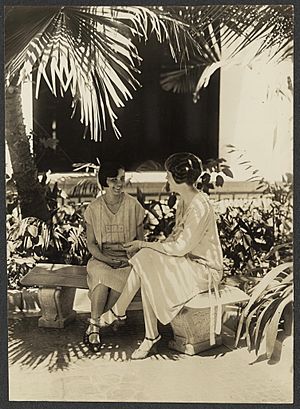
The first Inter-American Commission of Women (CIM) had seven women delegates. Their job was to finish the report for the next Pan-American Conference in 1933. This report would review civil and political equality for women. Stevens led the CIM from 1928 until 1938. By August, Stevens was back in Paris working on the report. She and other suffragists protested the French president, Gaston Doumergue, in 1928. They wanted world peace delegates to support an equal rights treaty. They were briefly arrested but released.
In 1929, Stevens returned to the United States. She began studying international law and foreign policy at American University and Columbia University. In February 1930, she went to Havana for the first CIM meeting. From Cuba, she went to The Hague for the first World Conference on the Codification of International Law. She presented her findings from the Americas. Stevens asked the international community to create laws to protect women's citizenship. She returned to her studies in the United States. In 1931, she became the first woman member of the American Institute of International Law. That same year, she, Belmont, and Paul attended the League of Nations meeting. They presented their findings on nationality.
Seventh Pan-American Conference
Stevens worked closely with Latin American feminists through the CIM. However, she sometimes focused on her own interests more than the concerns of others. For example, historian Katherine Marino notes that Stevens did not fund travel for some Latin American CIM members.
At the Seventh Pan-American Conference in 1933 in Montevideo, Uruguay, the women presented their study. It looked at the legal status of women in 21 member countries. This was the first report to study women's civil and political rights in such detail. It was prepared only by women. They proposed a Treaty on the Equality of Rights for Women. The conference rejected it, but Cuba, Ecuador, Paraguay, and Uruguay signed it. These countries had already given women the right to vote. However, none of them approved the Treaty after the conference. Still, the women had presented the first international idea to recommend voting rights for women.
Next, Stevens showed data on the differences in rights between men and women. For example, in 16 American countries, women could not vote at all. In two countries, they could vote with limits. In only three countries, they had equal voting rights. In 19 American countries, women did not have equal custody of their children. This included seven US states. Only two countries allowed women to have joint authority over their own children. No Latin American countries allowed women to serve on juries. Also, 27 US states stopped women from being on juries. Divorce laws in 14 countries and 28 states were different for men and women. In 13 countries and two US states, a woman could not manage her own separate property.
After seeing this data, the conference approved the first international agreement on women's rights. The Convention on the Nationality of Women stated that a woman could keep her citizenship if she married a man of a different nationality. The text said, "There shall be no distinction based on sex as regards to nationality." The conference also passed the Convention on Nationality. This said that marriage or divorce could not affect the nationality of family members. This extended citizenship protection to children too.
The Roosevelt government wanted to remove Stevens. They argued that the women's task was done and the CIM should be closed. The Conference did not want to give in to US pressure. They voted to block the US proposal, except for Argentina.
Later Career
It took President Roosevelt five more years, with help from the League of Women Voters, to replace Stevens. Roosevelt argued that Stevens was appointed by the Pan-American States, not as a US delegate. He agreed to make the CIM permanent if each state could appoint its own delegates. Once approved, he immediately replaced Stevens with Mary Nelson Winslow. Stevens did not leave quietly. The disagreement continued through 1939. Eleanor Roosevelt supported Winslow, while suffragists supported Stevens. Eleanor Roosevelt had several reasons for opposing Stevens. She did not think the Equal Rights Amendment would protect women. Also, she believed Stevens acted in an "unladylike" way.
In 1940, Stevens was elected to the National Council of the National Woman's Party. The next year, Alice Paul returned from Switzerland. She had been there for two years to start the World Woman’s Party (WWP). Problems arose. Paul faced challenges to her leadership of the NWP and had disagreements with members, including Stevens. When Alva Belmont died in 1933, she had promised money to Stevens for her years of service. But the money went to the NWP instead. Stevens sued and eventually received $12,000. However, she believed Paul had damaged her relationship with Belmont. After Paul resigned in 1945, Stevens did not support Paul's chosen replacement, Anita Pollitzer. Stevens led an unsuccessful attempt to challenge Pollitzer's leadership.
Stevens left the NWP in 1947. She then became active in the Lucy Stone League. This was a women’s rights group based on Lucy Stone's idea of women keeping their maiden name after marriage. After World War II, the organization was revived in 1950. This was because women's rights, which had grown during the war, were starting to go back to how they were before the war. Stevens was one of the people who helped restart the group. Stevens had always believed a woman should keep her own name. She did not take her husband's name in either of her marriages.
She remarried Jonathan Mitchell on August 31, 1935, in Portland, Maine. Mitchell was a reporter for The New Republic and later for the National Review. He was against communism. He took part in the Army–McCarthy hearings. After her marriage to him, Stevens' political views shifted more to the right.
From 1951 to 1963, Stevens served as vice-president of the Lucy Stone League. Stevens was not against men. Instead, she was strongly pro-female. She believed that for women to succeed, men did not have to be excluded. She thought working with men was very important. In her last years, Stevens supported the creation of feminist studies as a real field of study in American universities. She tried to establish a special professorship for feminism at Radcliffe College.
Doris Stevens died on March 22, 1963, in New York City. This was two weeks after she had a stroke. Princeton University has a special professorship in women's studies. It was created by the Doris Stevens Foundation in 1986.
Legacy
In 1986, Princeton University created a special professorship in women’s studies through the Doris Stevens Foundation. In 2004, the HBO film Iron Jawed Angels was made. It was about the early days of the suffrage movement. Doris Stevens was played by Laura Fraser in the film.
Images for kids
-
Doris Stevens, right, talking to Sra. Clara González at the Pan-American Conference of Havana, January 1928
See also
 In Spanish: Doris Stevens para niños
In Spanish: Doris Stevens para niños


